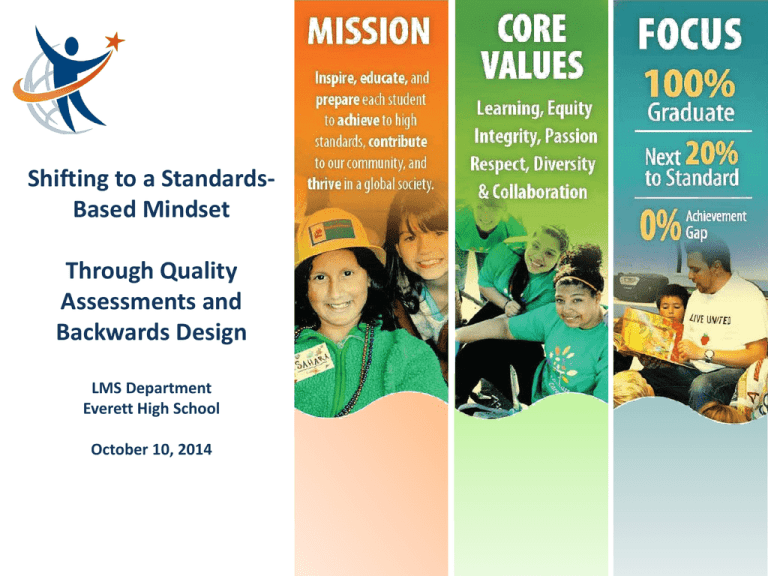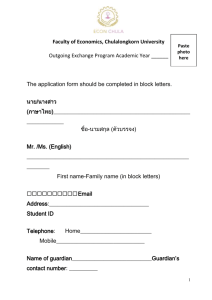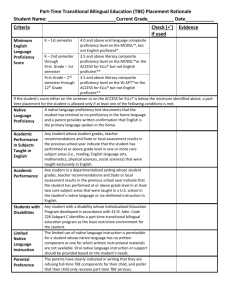EHS Grading Work Quality Asmt Training PE.CTE.Fine Arts 10.10
advertisement

Shifting to a StandardsBased Mindset Through Quality Assessments and Backwards Design LMS Department Everett High School October 10, 2014 Backwards Design Model Identify/Select Course Standards Common Core, NGSS, WA State, Industry, National Scale Standards Design/Use Common “Leveled” Assessments Instructional Plan/Map Determine Reporting/Grading Variables Develop Interventions/Enrichment Session’s Overview • Analysis of current course design • What is Backwards Design? • What makes an assessment “quality”? • What are some basics for assessment design? Intro Activity Select a class you are currently teaching. How have you chunked/organized the course for your students? • By units-If so what makes up a unit? • By topic- If so what topics? How do you organize the topics? • By performance typesTexts/products/mediums? Course Organization Template • Use the course organization template provided or create your own. • Develop a big picture overview of how you currently organize your course. What is Backwards Design? • To begin with the end in mind means to start with a clear understanding of your destination. It means to know where you're going so that you better understand where you are now so that the steps you take are always in the right direction. • —Stephen R. Covey, The Seven Habits of Highly Effective People Key Tenants 1. Identify desired results- What are the core standards for your course? 2. Determine acceptable evidence- How will you assess student learning? 3. Develop instructional plan- What learning experiences and instruction will you plan for your students? 1. Starting with our Standards • According to the state this is our curriculum – Our role is to find materials and organize our course in a way to best support students in meeting these standards Task • Determine the number of standards to be met within a semester timeframe. – What standards are the focus of your class – Which standards lend themselves to clear feedback for growth? – What standards will students be given multiple opportunities to meet proficiency during the semester? Use the course standards template and create a draft of the essential standards for your course for a specific timeframe (semester). 2. How can these standards be assessed? Assessment Method Continuum Informal checks for understanding Observation /Dialogue Quiz/Test Academic Prompt Performance task/project Determine Acceptable Evidence of Learning • How will you know that they learned it it? • How will you assess that they learned it? – What forms of assessment will demonstrate that the student acquired the knowledge, understanding, and skill to answer the questions. • What counts as understanding in your class? • What about in your content area? Assessment Analysis Activity • What assessment do you currently do where 1-2 of these standards could be emphasized and evaluated? • What revisions would be required? – Does it need a rubric? – Does it need to be enhanced to be a quality assessment (both reliable and providing valid data)? – Does the assessment assess varying levels of proficiency? Simple Quality Assessment Checklist • Reliability and Validity – Aligned to standard/target – Sufficient number of items for each standard – Type of item matches performance expectation – Items match instruction provided Increase Assessment Quality • Sufficient number of items to have evidence of student’s understanding of a standard • Sufficient number of items at levels approaching, meeting and exceeding proficiency – Best “type” of assessment item to measure level. • Strength of item to distinguish both correctness and misconceptions for instruction How can we be consistent in applying DOK for a given course? Depth of Knowledge = Cognitive Demand = Rigor • How much and what kind of “thinking” is called for in each set of standards (cluster, PE, ELAR)? • What tasks and contexts will students need to demonstrate proficiency? • What kinds of “thinking” is called for approaching the standard and advancing beyond? Clarifying Course Standards Cognitive demand and learning progression What is a Performance Task? An assessment activity that requires a student to demonstrate his or her achievement of a standard/learning target by producing a specific product. Designing A Performance Task Determine a Focus Create a Context Write Directions Develop a Scoring Guide • Target a standard or learning target • Determine the evidence of learning • Choose a significant question or an important problem • Develop a background scenario • Describe what students are expected to know and do • Describe the product or performance students are expected to develop • Develop a Rubric-Write descriptors of a quality performance • Use anchor papers or exemplars of student work Schimmer’s Progression Shifting to a Standards-Based Mindset Emphasize COMPLETION or STANDARDS? Is school about ACTIVITIES or LEARNING? Is school about POINTS or EVIDENCE? Is learning an EVENT or a PROCESS? Everett High School Current Language Purpose of Grading Statement End of Course Grades (Semester/End of Year): To communicate information about student proficiency on content standards to students, parents, educators and other stakeholders. Formative/Summative Grades: • To provide information to students for self-evaluation • To provide information to classroom/program to inform the next steps of the instruction • Common summative/formative assessments will be used frequently to inform student progress towards standard Welcome, Encourage, Inspire to Build Confident Learners



